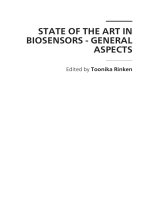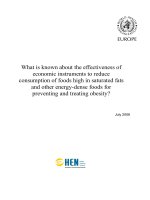SUSTAINABILITY OF RUBBER INDUSTRY IN MALAYSIA: ECONOMIC AND SOCIAL PERSPECTIVE pot
Bạn đang xem bản rút gọn của tài liệu. Xem và tải ngay bản đầy đủ của tài liệu tại đây (2.61 MB, 28 trang )
SUSTAINABILITY OF RUBBER INDUSTRY IN
MALAYSIA:
ECONOMIC AND SOCIAL PERSPECTIVE
Muhamad Thalhah Ab Karim
Paper Presented at IRRDB-CATAS International Rubber Conference
18-19 October 2010, Hainan PRC
CONTENT
1.Concept of Sustainable Development
2.Status of Malaysian Rubber Industry
3.Way Towards Industry’s Sustainability
4.Conclusion
CONCEPT OF SUSTAINABLE DEVELOPMENT IN
MALAYSIA
Environment
SocialEconomic
Meets present needs without compromising future
generations:
-zero burning
-use of organic fertilizer
-cover crop
-composting
-soil and water conservation
Rubber production and
processing practices are
required to carry out in a
socially acceptable way.
Increase income of
rubber growers and
remunerative return
on investment
STATUS OF THE MALAYSIAN
RUBBER INDUSTRY
RUBBER PLANTED HECTARAGE
Source: Department of Statistics Malaysia
Year
Planted Hectarage ( ' 000 ha )
Estate
Smallholding
Total Area
1990
348.70
1,487.96
1,836.66
2000
123.78
1,306.90
1,430.68
2005
57.37
1,213.93
1,271.30
2006
54.15
1,209.40
1,263.55
2007
53.40
1,194.70
1,248.10
2008
61.10
1,185.90
1,247.00
2009
61.10
960.44
1,021.54
RUBBER PRODUCTION BY SECTOR
(‘000 TONS)
Source: Department of Statistics Malaysia
128.13
99.53
68.39
56.23
58.2
799.47
1,215.24
800.79
941.8
927.60
1,283.63
857.02
1,000.0
-
200.00
400.00
600.00
800.00
1,000.00
1,200.00
1,400.00
2000
2001
2002
2003
2004
2005
2006
2007
2008
2009
2010e
Estate
Smallholding
Total Production
PROJECTION OF MALAYSIA’S NR PRODUCTION
‘000 tonnes
CAGR: 6.2%
6%
94%
Planted Area 2009
Estate
Smallholding
7%
93%
Production 2009
No. of Smallholders
400,598
With 94% of rubber planted areas and 93% of rubber production are from smallholding
sector, acceleration of smallholding’s development is needed to sustain NR industry
Source: RISDA, DOA Sarawak, Sabah Rubber Industry Board
1,289
1,358
1,361
1,344
1,372
1,381
1,525
1,520
1,600
1,620
1,630
1,184
1,167
1,211
1,270
1,296
1,320
1,358
1,414
1,420
1,440
1,500
1,226
1,211
1,237
1,280
1,300
1,320
1,370
1,420
1,430
1,450
1,500
1,000
1,100
1,200
1,300
1,400
1,500
1,600
1,700
2000
2001
2002
2003
2004
2005
2006
2007
2008
2009p
2010e
Estet
Pekebun Kecil
Purata
kg/ha/year
2009
Avg Yield
Smallholders
Estate
*Based on survey conducted by MRB
e-estimates
MALAYSIA LAND PRODUCTIVITY
(KG/HA/YEAR)
MAJOR ISSUES AND CHALLENGES
- Declining rubber planted area
- Inability to Attract New Participants to the
Industry
1,431
1,022
857.02
0
200
400
600
800
1000
1200
1400
0
200
400
600
800
1,000
1,200
1,400
1,600
2000
2001
2002
2003
2004
2005
2006
2007
2008
2009
Planted Area
Total Production
In ‘000 tonnes
PRODUCTION AND PLANTED HECTARAGE
In ‘000 ha
Source: Dept of Statistics Malaysia
With the decline in total planted area, policy has been formulated to ensure that
national production to be sustained at above 1.0 million tons to meet raw materials
requirement of the downstream sector.
STRATEGIES TO INCREASE PRODUCTION
• Increase replanting area by 40,000 ha per year
• To expand rubber area – new planting by 20,000 ha per year
• Accelerate replanting to high yielding clones – Clone
1Malaysia
• Promote mechanization and automation
• Enhance adoption in the latest technology in latex harvesting
(LITS)
Clone 1 Malaysia
LITS
Source: RISDA
e: estimate, p: projection
REPLANTING RUBBER TO RUBBER
(HECTARE/YEAR)
Replanting is a strategic program to improve the condition of smallholdings sector
5,222
7,233
19,029
19,043
19,408
20,586
20,212
23,152
20,688
21,203
25,000
40,000
-
5,000
10,000
15,000
20,000
25,000
30,000
35,000
40,000
45,000
2000
2001
2002
2003
2004
2005
2006
2007
2008
2009
2010e
2020p
LAUNCHING OF NEW CLONE RRIM 3001 OR
1 MALAYSIA CLONE ON 13 AUGUST 2009
INABILITY TO ATTRACT NEW PARTICIPANTS
TO THE INDUSTRY
The rubber industry has long been dubbed as a poor man’s industry due to
relatively low income.
The consequences were abandoned holdings and productivity declines amidst
uneconomic size holdings and skilled tappers shortage that plagued the industry.
The scenario of the industry has now changed. The current encouraging price of
rubber sustained at relatively high levels is a departure from the traditionally low
NR price. This has tremendous impact on income and returns of the upstream
sector.
COMPARISON OF PRICE AND PRODUCTION,
2009 vs 2010
500.89
756.75
994.38
1115.41
0
200
400
600
800
1000
1200
0
20,000
40,000
60,000
80,000
100,000
120,000
January
February
March
April
May
June
July
August
September
October
Production 2009
Production 2010
Avg Price 2009
Avg Price 2010
tons
etimate
sen/kg
With the increase in average price to a higher level this year, production has increased
by 15% y-o-y
AVERAGE MONTHLY INCOME OF
SMALLHOLDERS
The price of NR once a disincentive to tapping turnout has now become the major
driving force in exploitation of rubber.
276
1,900
1,440
2,395
285.98
831.37
637.36
987.04
-
500
1,000
1,500
2,000
2,500
3,000
0
200
400
600
800
1000
1200
2002
2003
2004
2005
2006
2007
2008
2009
2010*
Income ( RM )
Yearly Average Prices of SMR 20 (sen/kg)
* SMR 20 yearly average as at 13 October
Before (1980s)……
……Now
The recent steady cash inflow from rubber cultivation has changed the lifestyle of rubber
smallholders.
SOCIO-ECONOMY TRANSFORMATION OF
RUBBER SMALLHOLDERS
MEETING BALANCED DEMAND-SUPPLY OF NR
On the international front, to sustain price at acceptable levels, the Tripartite cooperation
among three major NR producing countries have “managed” their expansion programs
to ensure future supply of rubber does not exceed anticipated demand.
285.98
378.97
461.93
523.07
710.92
734.06
831.37
637.36
987.04
2002
2003
2004
2005
2006
2007
2008
2009
2010*
Yearly Average Prices of SMR 20 (sen/kg)
World NR
Consumption
9.5 mil tons
World NR
Production
9.6 mil tons
2009
Source: Malaysian Rubber Exchange & International Rubber Study Group (IRSG)
* SMR 20 yearly average as at 13 October
WAY TOWARDS INDUSTRY’S SUSTAINABILITY:
• Strategies and Initiatives
• Transformation of Rubber Industry
- Restructuring the Rubber Smallholdings
- Increase Supply Chain Efficiency
HIGH-INCOME NATION
Projected
GNI per
capita
(2020
1
)
RM48,000 or
US$15,000
Current GNI
per capita
(2009
2
)
RM23,700 or
US$6,700
MIDDLE-INCOME NATION
1
At 2020 prices, consistent with Economic Planning Unit (EPU)
assumptions for inflation= 2.8% and population growth=1%
2
2009 population 27.9 million, 2020 projected population 31.6 million (EPU projection)
Source: World Bank, Economic Planning Unit, Department of Statistics
ECONOMIC TRANSFORMATION PROGRAMME
• To transform Malaysia to become a high income and high
productivity economy
• Two main targets:
i.To increase national income per capita to RM 48,000 by
2020 (from RM 23,700)
ii.To achieve real GDP of 6.0% per annum
Sustaining Malaysian Rubber
Industry Contribution To A High
Income Economy
MALAYSIAN RUBBER INDUSTRY
STRATEGIES, 2010-2020
• NR production to increase to 1.8 million tons with productivity of 1.8 tons per
hectare by 2020
• Annual income of smallholder to increase by 25% from RM28,000 to RM35,000.
INITIATIVES
• Effective TOT
• R&D
• High yielding
clone made
available
Environmax
method –
improvement in
procedures of
selecting hevea
clones for planting
recommendation
Green Technology
Financing Scheme
- enhance
Malaysia’s
competitiveness
in low carbon
economy.
RESTRUCTURING SMALLHOLDING
• Significant transformation took place in the
smallholding sector by the way of land and management
consolidation into cooperative or cooperation
• Agencies responsible in smallholder development –
FELDA, RISDA, FELCRA
• Central management/large scale holdings would
benefit from economies of scale
IMPROVE MARKETING-CHAIN EFFICIENCY
Smallholders
Rubber
Dealer(s)
Processors
Issues of
transparency in
farmgate price
determination









